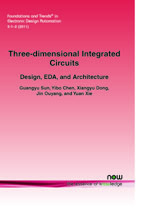Three-dimensional Integrated Circuits: Design, EDA, and Architecture
By Guangyu Sun, , gsun@cse.psu.edu | Yibo Chen, , yxc236@cse.psu.edu | Xiangyu Dong, , xydong@cse.psu.edu | Jin Ouyang, , jouyang@cse.psu.edu | Yuan Xie, Pennsylvania State University, Computer Science and Engineering Department, University Park, USA, yuanxie@cse.psu.edu
Abstract
The emerging three-dimensional (3D) integration technology is one of the promising solutions to overcome the barriers in interconnection scaling, thereby offering an opportunity to continue performance improvements using CMOS technology. As the fabrication of 3D integrated circuits has become viable, developing CAD tools and architectural techniques are imperative for the successful adoption of 3D integration technology. In this article, we first give a brief introduction on the 3D integration technology, and then review the EDA challenges and solutions that can enable the adoption of 3D ICs, and finally present design and architectural techniques on the application of 3D ICs, including a survey of various approaches to design future 3D ICs, leveraging the benefits of fast latency, higher bandwidth, and heterogeneous integration capability that are offered by 3D technology.
Three-dimensional Integrated Circuits
Three-dimensional integrated circuits (3D ICs) offer many benefits for future microprocessor designs. Amongst these is the potential for overcoming the barriers in interconnect scaling, thereby offering an opportunity to continue performance improvements using CMOS technology. As the fabrication of 3D integrated circuits has become viable, developing CAD tools and architectural techniques are imperative for the successful adoption of 3D integration technology. Three-dimensional Integrated Circuits: Design, EDA, and Architecture presents the background to 3D integration technology and discusses the major benefits it offers. It goes on to review the EDA challenges and solutions that can enable the adoption of 3D ICs. It finally presents design and architectural techniques in the application of 3D ICs, including a survey of various approaches to design future 3D ICs, leveraging the benefits of fast latency, higher bandwidth, and heterogeneous integration capability that are offered by 3D technology. The cost of 3D integration is also analyzed in the last section. Three-dimensional Integrated Circuits: Design, EDA, and Architecture is an ideal primer for researchers, graduate students and field practitioners who are interested in 3D ICs and the benefits and challenges of adopting them.
